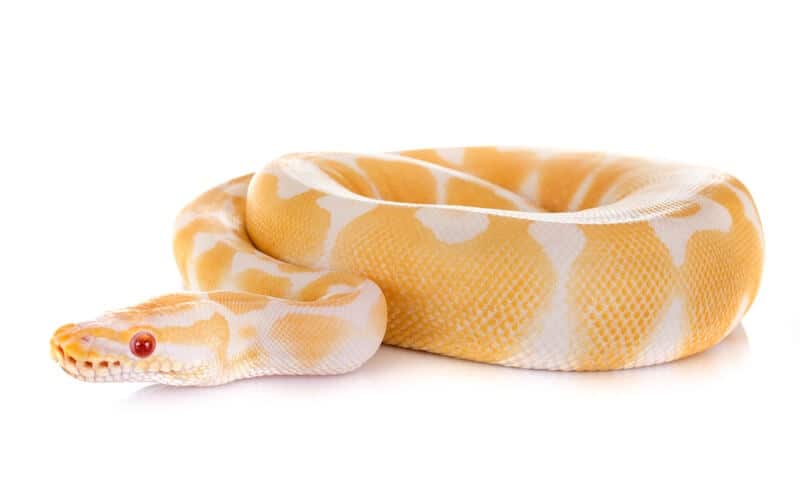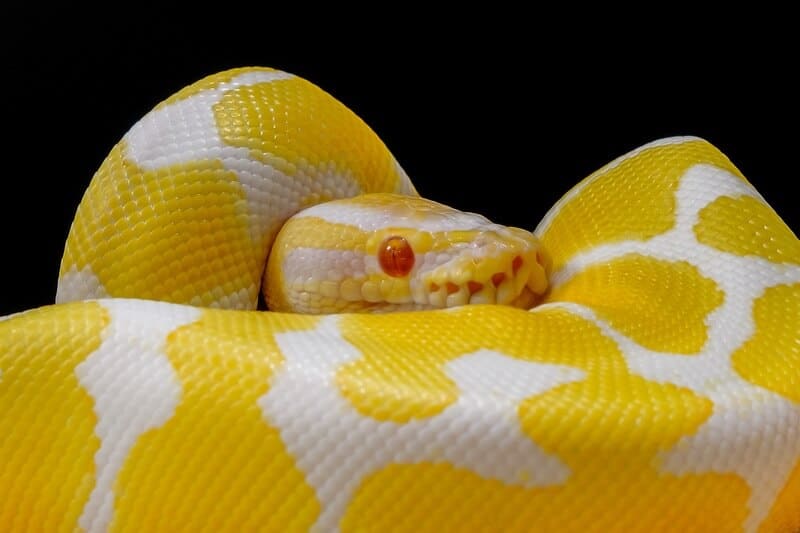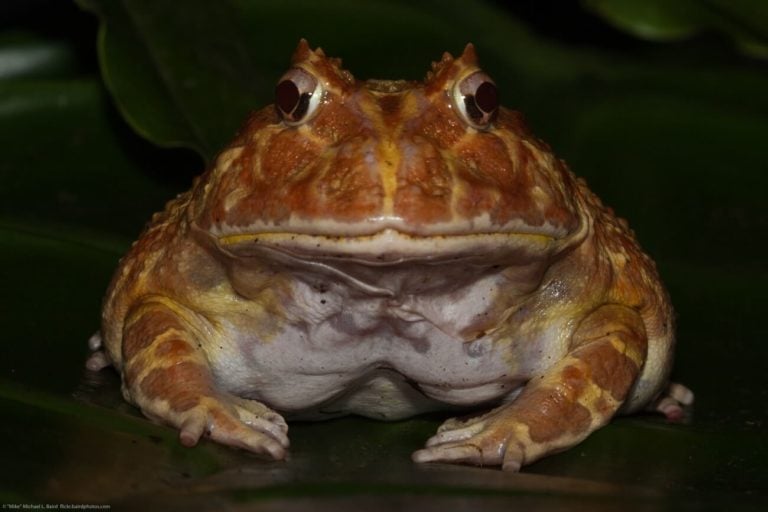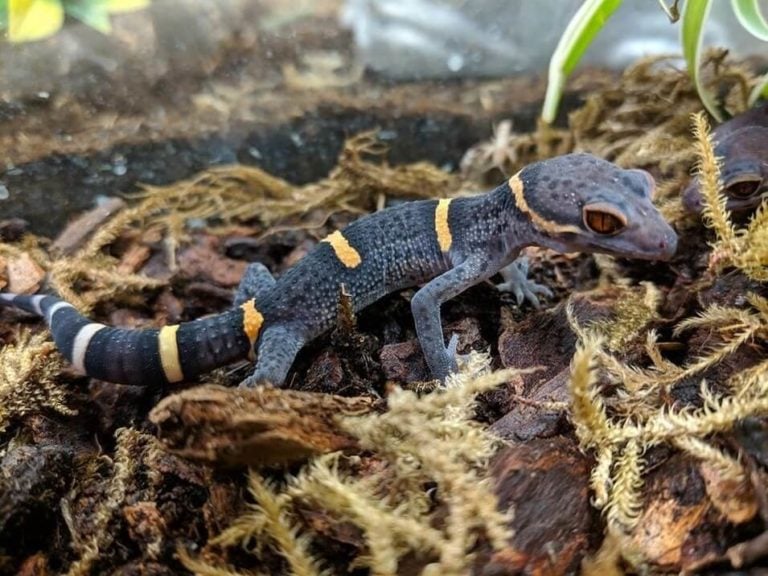Albino ball pythons are beautiful snakes that can make great pets for just about anyone. It doesn’t matter what your experience level is, these snakes are quite manageable!
This guide will teach you everything you need to know about albino ball python care. We’ll also cover their size, diet, habitat setup, and other useful information!
Table of Contents
Species Summary
Albino ball pythons are the quintessential “beginner’s” reptile. Ball pythons are very common pet snakes, and their generally docile nature makes them an excellent choice for newer enthusiasts. Despite their somewhat intimidating appearance, these snakes are easy-going. Pair that with their straightforward care requirements, and you don’t need to be a pro to keep them happy!
These snakes come from West Africa. It wasn’t until the 1980s that they experienced a massive boom in popularity. But there were slim pickings when it came to color.
Standard ball pythons are typically light brown and feature a pattern of dark brown or black markings. While that standard colorization is certainly beautiful, reptile enthusiasts wanted more! So, breeders went to work creating unique color morphs.

Today, there are an estimated 4,000 or more ball python color morphs in existence! The albino ball python was one of the first unique color variations to become widely available, proliferating on the market in the early 1990s. Its wide availability is likely due to its ease of breeding.
Albinism occurs naturally in the wild, so isolating and preserving those genes wasn’t difficult. In fact, albino ball pythons play a key role in creating more exotic color morphs like bumblebee, banana, enchi, and more.
These gorgeous snakes are still readily available, eagerly waiting for a new owner who can care for their needs.
Appearance & Colors
Albinism is a genetic condition that causes these snakes to have very little melanin in their skin. Melanin is natural pigmentation. Without it, these snakes look like colorless versions of the standard snake.
Of course, not all color is absent. Most albino ball pythons have bright yellow and pinkish-white skin. The interesting thing about albino snakes is that they retain distinct patterns. The only difference is that it’s devoid of the signature brown and black hues.
The eyes are another notable difference between albino ball pythons and standard ball pythons. Instead of the beady black eyes, albino variants have reddish-pink eyes. They’re also sensitive to light, which results in some critical differences for tank setup. More on that soon.
Overall, ball pythons are long and stocky snakes. Their bodies can get pretty girthy, creating substantial weight as the reptile grows bigger.
Expert Tip: Sexual differences are super subtle. Trained herpetologists may have the experience to identify the males and females by eye. Generally, males have shorter and thicker tails. Meanwhile, females are often slightly bigger overall.
Because of the striking similarities, most people can’t tell the difference based on size alone. Probing is the best way to sex these snakes for breeding.
Lifespan
The typical lifespan of an albino ball python is 30 years or more when kept in captivity. That’s amazing news for these genetic oddballs. Albino animals often don’t live as long as their pigmented counterparts in the wild.
Even a strong snake like an albino ball python has its enemies. Without pigmentation, these snakes cannot blend in with their surroundings and evade capture. They’re easy to spot in a natural environment, making them an easy feast for predators.
Luckily, they can thrive in captivity.
Of course, there are no guarantees with any animal. Albino ball pythons have distinct needs you must meet when it comes to care. Otherwise, they can succumb to disease and poor health like any creature living in captivity.
As a snake owner, it’s your job to ensure that you cover all of their bases to provide a long and happy life.
Average Size
The average size of an albino ball python is about three to five feet in length when fully grown.
Expert Tip: Females are more likely to reach the upper limits of that size spectrum. Males will usually stay closer to three or four feet.
Albino Ball Python Care
There’s no denying that the albino ball python is a thing of beauty! Its bright yellow skin and pink eyes are a sight to behold. But before you visit a breeder or pet store to pick one up for yourself, there are some things you need to know.
Albino ball pythons can be a joy to care for thanks to their straightforward needs and peaceful nature. But like any other living animal, they have some essential care requirements to cover.
Here are the essential guidelines to remember.
Enclosure Size
The first thing to do is choose an appropriate living space for your ball python. You have many options, but sizing is the most important thing to consider.
Albino ball pythons should live in an enclosure that holds at least 55 gallons. You can go a little bigger to give your snake some room to stretch out. As a general rule of thumb, the length of the tank should be long enough to let your snake unwind fully.
That said, don’t go too big! Albino ball pythons prefer small and confined places with ample room for hiding. Enclosures that are too expansive can cause undue stress.

So, what type of habitat should you provide? That’s entirely up to you.
Collectors often utilize plastic bins. They’re cheap, convenient, and can make reptiles easier to care for if you have many of them. But with a snake as beautiful as this, you might want to go for a glass enclosure.
Glass aquariums, reptile terrariums, or even vivariums work well. Make sure that the enclosure has a robust lid for security and plenty of opportunities to control airflow. That means adjustable vents or a mesh top.
What To Put In Their Habitat
You don’t have to get super fancy with the decor. Many albino ball pythons will be quite happy with just the basics.
Start with a layer of substrate material that’s safe and supportive of the ideal humidity levels. The best choice for adult albino ball pythons is cypress mulch or aspen bedding. The material is all-natural and can absorb moisture to keep humidity levels stable.
Avoid anything too rough. Your snake’s underbelly is prone to scratches and abrasive damage.
Consider using something even softer than cypress mulch or aspen if you have younger snakes. Newspaper or paper towels are a suitable choice. You can also utilize reptile carpet as a low-maintenance option.
The goal here is to choose an affordable substrate that’s easy enough to clean and replace frequently. Younger snakes make messes more often, opening them up to a higher risk of disease and infection.
Once the substrate matter is settled, you can move on to decor. Albino ball pythons don’t need much. You’re free to go as simple or complex as you want.
One essential to have is a hide box. You can buy a plastic hide box from reptile companies or make your own out of wood. Either way, it needs to be big enough for the snake to slither in and ball up.
Hide boxes can make your snake feel more comfortable and confident. Think of it as their safe spot. Many will also use it for thermoregulation and humidity management.
Expert Tip: In addition to the hide box, you can add rocks and faux plants for coverage. Just make sure that there are no jagged edges or rough textures that could harm your snake.
Temperature & Lighting
These snakes are used to warm environments. Even if they never spent a day in West Africa, the need for warmth is paramount.
Like all other snakes, albino ball pythons thermoregulate. That means that they move to different temperature zones to get comfortable. Because you’re working with a small, confined area, you have to get creative to create the temperature gradient these snakes need.
Most snake-keepers use standard overhead heating lamps. They do double-duty, illuminating the enclosure while also providing the heat these creatures need. Alternatively, you can use heat emitters or under-tank heating pads.
Either way, arrange the lights to create a gradient. Here are the ranges to keep in mind:
- On the “cool” side of the habitat, temperatures should be between 76 and 85 degrees Fahrenheit.
- On the opposite end, install a basking light. The basking light needs to raise the temperature on one side of the enclosure to readings of 88 to 92 degrees.
Expert Tip: Albino ball pythons are pretty tolerant of subtle temperature fluctuations. However, don’t let the habitat get colder than 75 degrees or hotter than 95 degrees. Anything outside of that range can be lethal!
Usually, reptiles need UV light to synthesize calcium and avoid bone problems. That’s not the case here. Albino ball pythons are crepuscular and don’t rely on sunlight too often.
That’s because their eyes are super sensitive to UV light. Adding even a low-powered UV lamp could cause more harm than good! Stick to standard lights to keep your snake healthy and comfortable.
Humidity
Humidity is another vital aspect of albino ball python care. It’s always a good idea to invest in a hygrometer to keep track of airborne moisture levels.
While albino ball pythons are flexible, too much or too little humidity can cause many health problems (we’ll get into that a bit later).
The target range for albino ball pythons is 45 to 75 percent humidity. Ideally, humidity levels should hover between 55 and 60 percent.
There are a few ways to raise the humidity. The most straightforward way is to mist the enclosure with clean water every day. You can even buy an automatic water dripper or misting system.
You shouldn’t have too many problems maintaining relative humidity with an absorbent substrate. If you’re dealing with too much moisture in the air, open up the tank’s vents. Increase air circulation, and the levels should steadily drop.
Check on the humidity frequently. It’s one of the most critical parameters to keep an eye on.
Water
Don’t be surprised if you never see your albino ball python drink water through their mouths. Some snakes learn to do that to stay hydrated. However, many others will take in water through other means.
Either way, you must make fresh and clean water available at all times. Install a shallow water bowl that’s big enough for the snake to get in. Many love to soak in their water dishes when trying to shed their old skin. Some will also use it to thermoregulate.
The dish should be shallow enough to avoid drowning but easy to slither in.
Make sure to clean and replenish the water daily. Snakes can get pretty messy, and many will defecate in the water bowl when it’s available.
To be on the safe side, consider treating the water beforehand. It’s best to remove chlorine and other chemicals by using reptile-safe water conditioners when possible.
Albino Ball Python Food & Diet
Feeding your albino ball python can be an enjoyable experience. It’s one of the only times that these snakes show a high level of activity.
Expert Tip: Juveniles will need to eat once a week. However, adults can go seven to ten days between meals depending on their size.
Many food options are available, but the go-to for most snake owners is feeder rodents. Mice and rats are readily available at most pet stores. While some reptile enthusiasts like to feed these animals when they’re still alive, it’s not a good idea.
Albino ball pythons are pretty docile. While they’re strong enough to take down prey, many are more passive. If a feeder rodent tries to fight back, you could end up dealing with some severe injuries and a high risk of infection.
It’s best to provide pre-killed and thawed rodents.
Choose rodents that are no bigger than the widest part of your snake’s body. You’ll have to adjust as your snake gets larger in size.
In addition to feeder rodents, you can give your snake the occasional treat of rabbits, gerbils, quails, and other protein-rich foods.
Potential Health Issues
Albino ball pythons aren’t immune to health concerns. Like other snakes, they can suffer from many ailments related to their environment.
Respiratory infections are widespread among captive snakes. They’re usually a product of improper humidity levels and ambient temperatures. The tissue inside the nostrils and throat becomes infected, leading to discharge and many painful symptoms.
Mouth rot is a similar concern. It can make your snake breathe with its mouth open as cheese-like discharge flows from the nose.
Make sure to keep an eye on enclosure conditions to avoid these nasty problems!
Snake skin mites and bacterial infections are common as well. The best thing you can do to avoid bacteria or mold-based problems is to clean the enclosure regularly.
Always spot clean messes as they occur. Keep an eye on the water bowl and clean out any gross stuff that might collect in there. Replenish the water often to keep it fresh and safe.
As for the rest of the tank, complete sanitization is necessary. Most reptile enthusiasts recommend deep-cleaning the habitat once every month. Use a reptile-safe disinfectant to keep the bacteria under control.
Behavior & Temperament
As a whole, ball pythons are pretty shy. They like to stay out of the spotlight. Albino ball pythons tend to be even more discrete because of their sensitivity to light.
Don’t be surprised if your snake spends most of its time in the hide box or coiled up in the shadows. They rest throughout the day and are most active at dawn and dusk.
Albino ball pythons like to coil up in a ball when they feel threatened and remain motionless. Give your snake plenty of places to hide. With more hidden nooks and crannies in their environment, they’ll feel safer.
It can take some time, but albino ball pythons will eventually grow accustomed to their surroundings. You might see them perform a behavior called “periscoping.”
This is when the snake lifts its head off the ground to look around. They become alert and will often hover there for a few minutes as they take everything in.
Aggression is rare, but it can occur. If you see your snake coiling up in a ball, give them space. If they lean back and coil into an “S” shape, back off quickly! That’s a warning sign that they’re about to strike.
For the most part, albino ball pythons are too peaceful and shy to cause trouble. But it’s always a good idea to be wary of the signs just in case.
Handling Them
Albino ball pythons can learn to be handled with time.
However, their attitude towards it will largely depend on their upbringing. That’s why it’s so important to socialize these snakes at a young age. When you start early, they become used to the sensations.
Start slow and give your snake all the space they need to get comfortable. Lift them at the midsection and support as much of their body as you can. Once you have them out of the enclosure, give the snake a moment to settle and get comfortable.
In their early years, limit handling to only a few minutes. Remember: These snakes are naturally shy. You must take things easy and let them get used to the new experience.
If you’re patient, your albino ball python shouldn’t mind handling as an adult.
As always, avoid handling the snake too often. Be wary of handling before and after feeding times, too.
Conclusion
Albino ball python care is something that anyone can do. It doesn’t matter if you’re a beginner or an experienced reptile-lover, these snakes are very low-maintenance!
If you have any questions about these pet snakes or any of the information in this guide, send them our way! We’re always happy to help our readers.


